10 good reasons to travel by train in Switzerland
Switzerland has one of the densest and longest rail networks, the most punctual service and some of the most spectacular mountain railways in Europe. Even the station clocks are legendary. Experience junkies are enthralled by extreme mountain railways that take them to the highest peaks and the most far-flung spots imaginable in this pioneering land of rail. By bike on the train or from train to car, whether for business or with family. Lorries go piggyback on freight trains right through Switzerland.
1. Rail network
Railway fever swept across Switzerland at the end of the 19th century, leaving in its wake scarcely a village or valley – however remote – unconnected to the international rail network. All kinds of technological possibilities were used to achieve this, including cog railways, funiculars and cable cars. Today, a dense rail network covers some 5,100 km through the whole of Switzerland (FSO 2014). Most railway lines (3,173 km) are operated by the Swiss Federal Railways (SBB), followed by BLS (520 km) and a further 38 private railway companies.
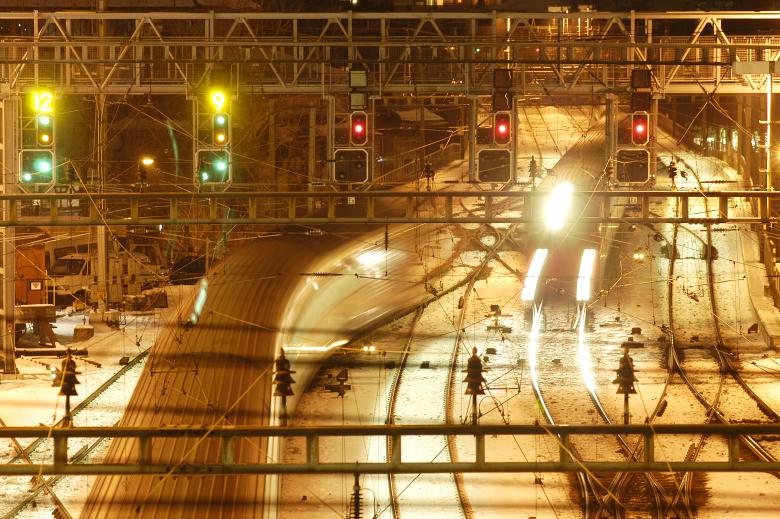
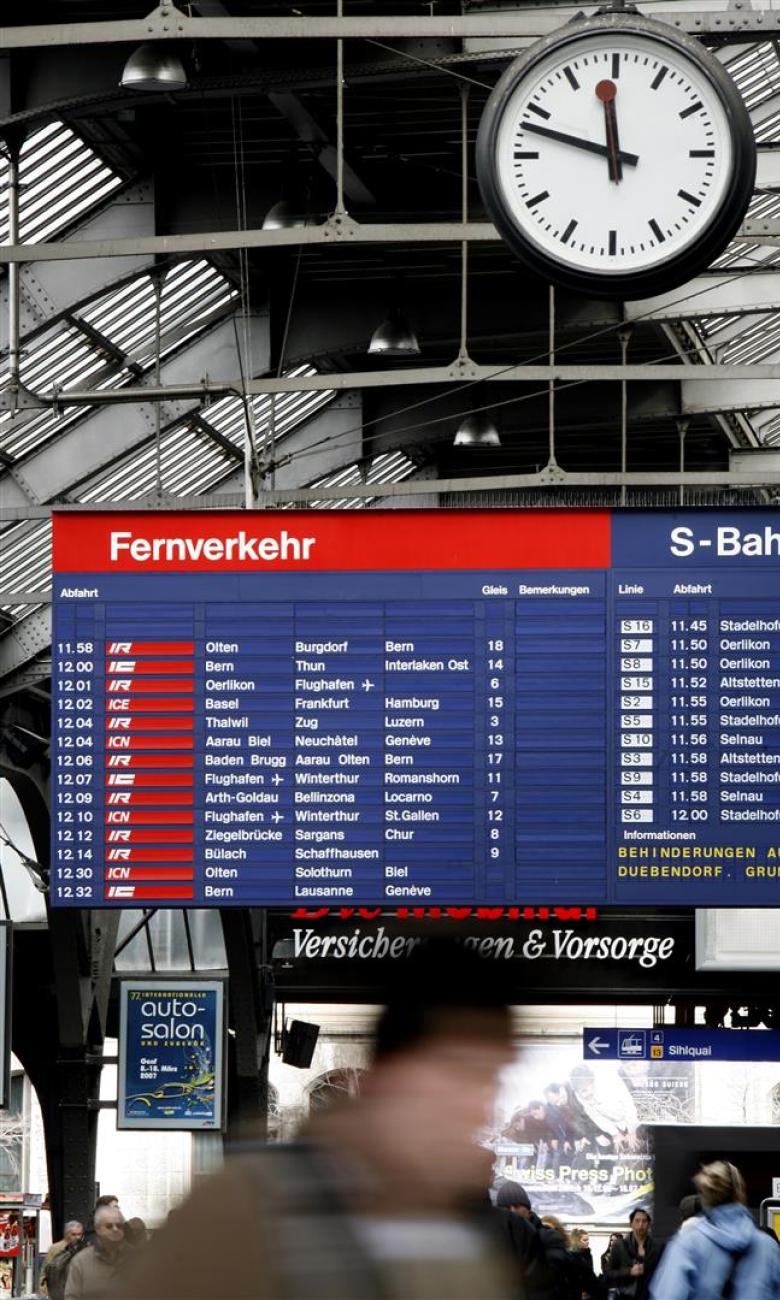
2. Simply the best
The Swiss Federal Railways come first place in the European Railway Performance Index 2015, ahead of the rail companies of Sweden, Denmark, France, Finland and Germany.

3. Right on time
Swiss trains are punctual – you will almost never have to wait for your connection. This is due to Switzerland's clock-face timetable: during the day at least one train per hour leaves every station in at least one direction. Zurich is at the heart of this strictly timed rail network, with trains arriving just before the hour at the central station and leaving it just after the hour. Behind the clock-face timetable is the Spinner Club which successfully fended off competition from road traffic: while the number of passengers fell to 216 million from 1970 to 1980, after the introduction of the clock-face timetable it increased to 264 million by 1990 and 430 million by 2014.

4. Record-breaking tunnels
Over 350 km of Swiss railway tracks pass through tunnels: one of the oldest in the world was the Gotthard Tunnel, opened in 1882 and some 15 km long. Since June 2016 it has been replaced by the new Gotthard Base Tunnel, with a length of 57km the longest rail tunnel in the world. Through the two tunnels leading from Erstfeld to Bodio up to 325 trains a day are travelling with a speed up to 250 km/h, shaving one hour off the previous journey time. The new tunnel is doubly good for freight traffic, which is piggybacking on freight wagons to reach its destination faster than before, and with the added advantage of protecting the Alpine landscape, thanks to the 'rolling highway' system.

Record-breaking underground: Switzerland does not have much of an underground railway to speak of, but the one in Lausanne is a world record-breaker, with 336 metres between its highest and lowest points.
5. Timetable
Swiss trains follow a sophisticated clock-face timetable: they depart at regular, periodically repeated intervals and are closely linked with almost all public transport systems, cutting waiting times to a minimum for connecting journeys. The integrated clock-face timetable introduced in 1982 (a train every hour, uniform symmetry minute on all routes) brought a sharp increase of 31% in the provision of long-distance trains. The system was enhanced with the 'hub' principle of Rail 2000, guaranteeing hourly and half-hourly departures in both directions between all main hub railway stations in the country. This system has proved itself to be effective and is used as a basis for the current timetable.

6. 'My' train
Whether you're a child, a businesswoman, a sports enthusiast, a family with a dog, or a pensioner, just about everyone's needs are catered for. Children are free to run around and play in the 'Ticki Park family coach' – a veritable playground on wheels. In the meantime, workaholics can get to it in the business compartment, which is equipped with tables, power sockets and internet access. Those in search of some peace and quiet will take their seats in the quiet compartment, where mobile phones are not allowed. Sports enthusiasts meanwhile can take their bike with them onto the train and hang it on the special hook. On board there's a place for everyone. Some people even have a model train at home or even entire miniature railway landscapes, depending on how much space they have. Model trains have a big fan base. Some model train layouts are open to the public. And of course these train enthusiasts will make the pilgrimage along with other interested parties to the numerous events organised by railway companies, they subscribe to railway magazines, visit museums, and take numerous photos and post them online with hashtags ranging from the nostalgic to the ultra-modern.
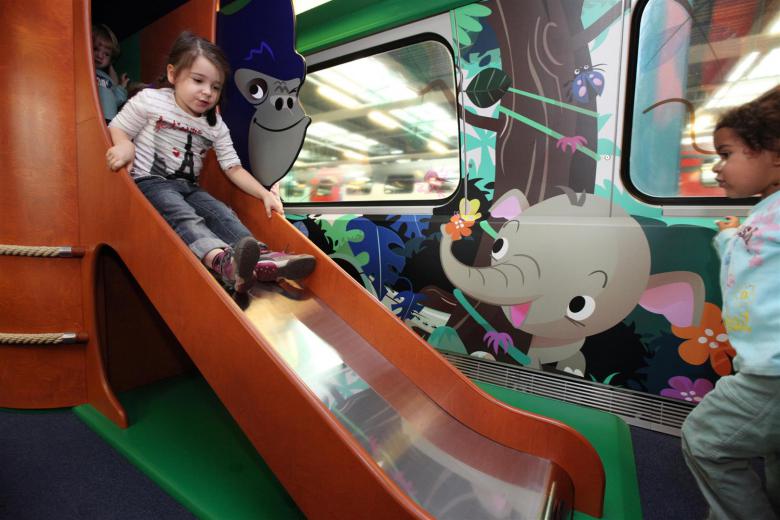
7. Juggernauts on rails
As a transit country on the north-south corridor and at the same time a mountainous land, Switzerland faces particular challenges with heavy traffic. The Alpine Initiative adopted in 1994 led to a steady expansion of ways to transfer freight from road to rail. Today containers are no longer simply loaded onto freight wagons: now, thanks to the 'rolling highway', even 44-tonne heavy goods vehicles can cross Switzerland at the weekend (during HGV driving ban), while the driver sleeps for nine hours and thus gets his statutory rest period. Over 100,000 lorries crossed the Swiss Alps in 2015 on the rolling highway via Lötschberg-Simplon. Of the net total of 140.6 million tonnes of goods which crossed the Alps in 2013, 47.5 million tonnes were transported by rail – already a rising trend.
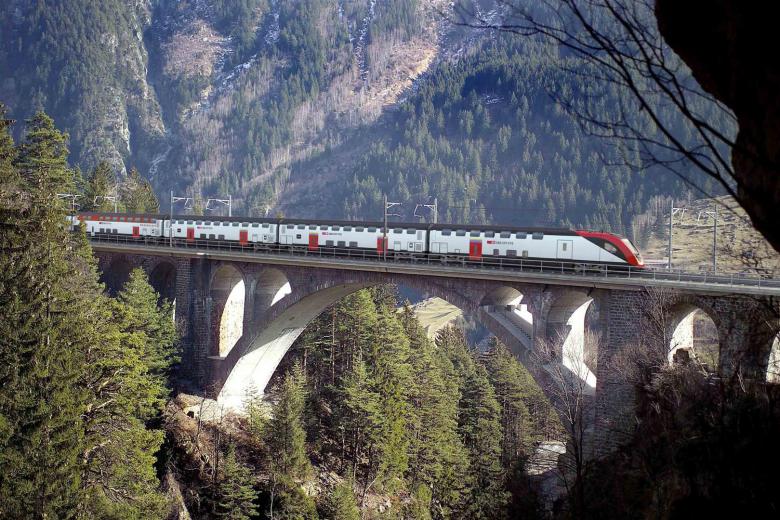
8. The cult railway clock
Unchanged since 1944 and still highly sought after: the railway clock design by Swiss engineer and SBB employee Hans Hilfiker. 20 million Swiss francs. That was the amount Apple had to pay the SBB in 2013 for the unlawful use of the clock face on its iPad. The Mondaine clock in simple Bauhaus style with its stylised red conductor's traditional signal ladle as second hand is famous for its delayed jump to the next minute (approx. 1.5 seconds) and this is still of great importance to modern-day rail travel in Switzerland: as the trains always leave the station precisely on the minute, it is easier this way for passengers to judge how much time is left before departure. The clocks are ubiquitous in Swiss railway stations, but can also be found in people's houses on kitchen walls and in watch format on people's wrists etc and digital fans of the clock are growing in number too. Originals of the railway clock are also on display at the Museum of Modern Art in New York and the London Design Museum.
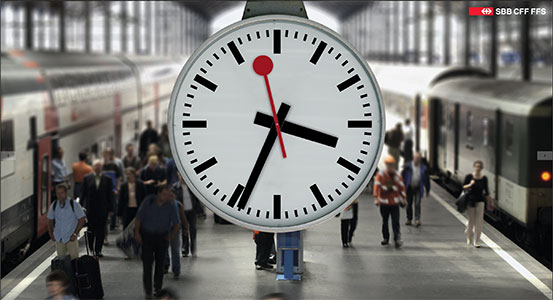
9. Thrill rides
Custom-built railways using custom-made systems and materials to access the most far-flung corners of the mountains. Some of the historical railways of Switzerland have been carefully restored to working order and modernised. A thrill-packed ride is guaranteed.
This is no roller coaster in an amusement park. It was a funicular opened in 1926 leading from the Haslital up to the Grimselpass at 1,859m. The gradient reaches up to 106% and the open car makes it the steepest railway in Europe with a guaranteed wow factor.
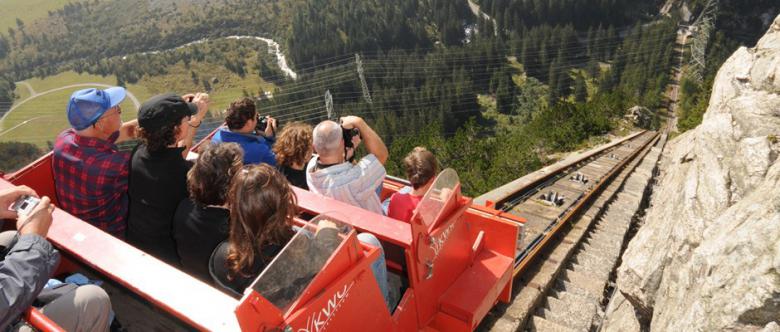
Anyone boarding the oldest funicular (1879) to go from Lake Brienz to the Giessbach waterfalls will get there without an engine: to this day the mechanism still works solely by water gravity, which pulls one car down while the other is pulled up. At the time of its inauguration it was the first automatic passing system in the world, allowing both cars to be operated simultaneously. It was awarded the accolade of 'Historic Mechanical Engineering Landmark' by the American Society of Mechanical Engineers in 2015.
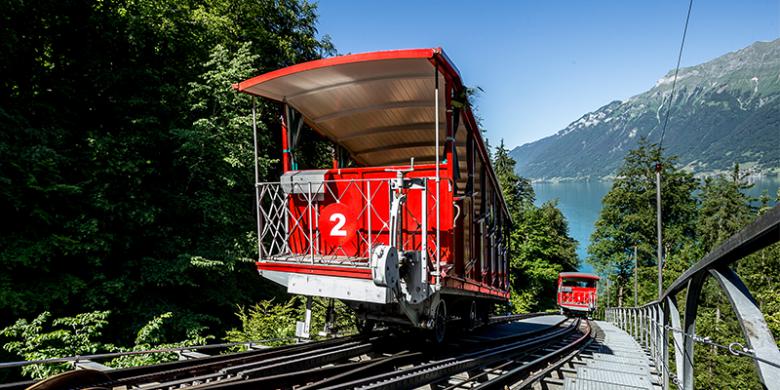
At 152 metres it was not only the longest but also the fastest lift in the world: the Hammetschwand lift on the Bürgenstock near Lucerne at 1,132 m above sea level. Not for the faint of heart: many passengers had turned pale by the time they reached the top. The lift moves somewhat more slowly today – the ride takes just under one minute and remains even after 110 years just as spectacular as the panorama from the Hammetschwand.
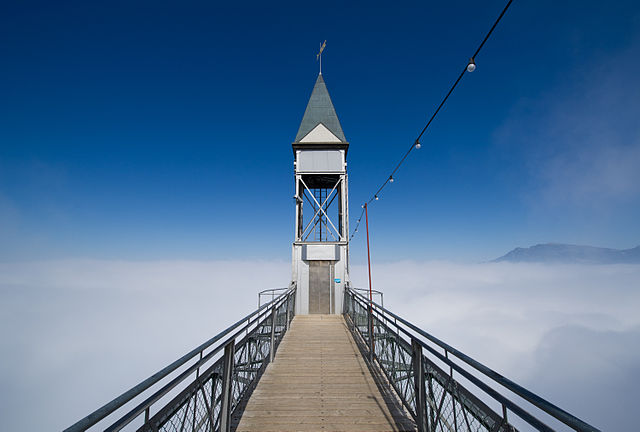
The Rigi was first climbed on foot by thousands of pilgrims, then later by writers such as Goethe and Mark Twain, and by Queen Victoria in 1868 – on horseback – who wrote enthusiastically in her diary: “We are amused!” In 1871 came a technological sensation: the first cog railway in Switzerland running from Vitznau to the Rigi. The old trains still operate along the original route using the rolling stock from the period.

The longest staircase in the world and the longest funicular in Europe – the Niesenbahn appears not just once in the Guinness World Records. The Niesenbahn runs from Mülenen to the Niesen, a pyramid-shaped mountain, above Lake Thun. The stairs next to the track with their 11,674 steps are open only for the annual Niesenlauf race.
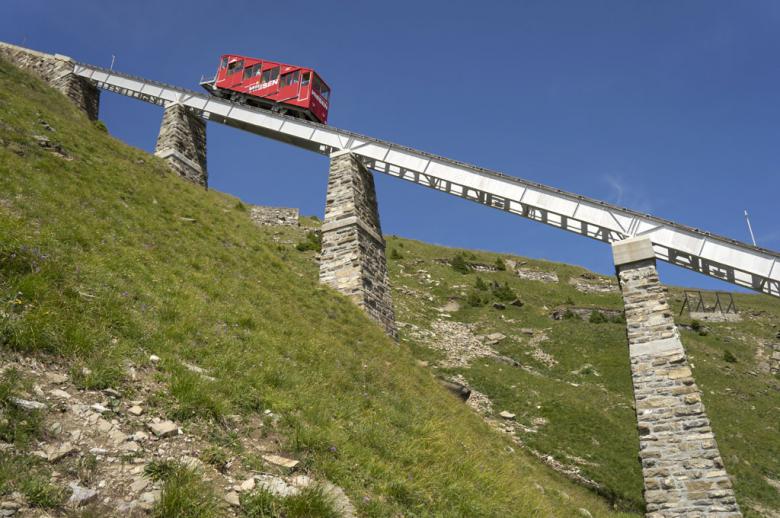
Built in 1968, the Schilthornbahn was at the time the longest cable car in Europe, with 7,000 metres of cable and 2,103 metres difference in altitude. At the summit, the futuristic aluminium-clad revolving restaurant 'Piz Gloria' provided a 360 degree panoramic view. The cable car only became truly famous however after it served as a spectacular backdrop in the James Bond film 'On Her Majesty's Secret Service'. From then on the tourists flocked to see it. The helicopter landing pad created for the film is now a magnificent viewing platform. Even today, you can still immerse yourself in the film by visiting the 'Bond World' exhibition or the cinema, or by tucking in to the special 007 breakfast.
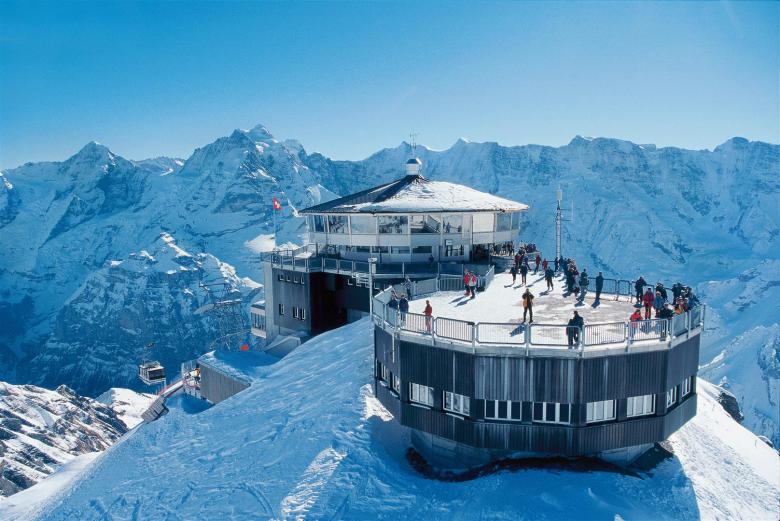
10. Carefree tickets
It's doesn't get easier than this: ONE ticket for all of the railways, buses and boats across the whole of Switzerland. The Swiss Travel System is a network encompassing 26,000 km of public transport routes. The 'transit ticket', the half-price reduction for one month, the Family Card and the Regional Pass are some other handy options. More information on the tickets.




